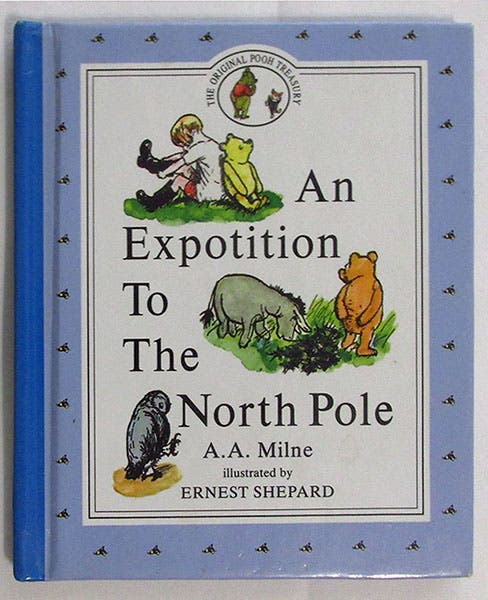Scientist of the Day - Winnie-the-Pooh
We have frequently featured, as Scientists of the Day, those intrepid British explorers who, throughout the nineteenth century and into the twentieth, attempted to traverse the Northwest Passage or reach the North Pole. Two examples are William Edward Parry and Sir John Ross; there have been many others. Today we call attention to one of the least heralded British polar expeditions, which began in England some time before 1926. The leader was a young lad named Christopher Robin, and he was accompanied by an owl, a donkey, two kangaroos, a rabbit (plus his friends and relations), a piglet, and a rotund little bear named Winnie-the-Pooh. The expedition (or expotition, as Winnie-the-Pooh called it) began and ended in the Hundred-Acre Wood and was fraught with peril, as first Winnie accidentally sat on Eeyore's lunch, which happened to be a thistle, and then they ran into an ambush ("'What sort of bush?', whispered Pooh to Piglet, 'a gorse-bush?' 'My dear Pooh,' said Owl in his superior way, 'don't you know what an ambush is?... an ambush is a sort of surprise.' 'So is a gorse-bush, sometimes', said Pooh.") Then Roo, the smaller of the two marsupials, fell into a stream and had to be rescued; he was finally snagged and pulled from the water by Pooh-bear, wielding a long pole that he found. Christopher immediately recognized the Pole and realized that the expotition had reached its goal. Winnie's prize was taken home and stuck into the ground, bedecked with a sign, made by Christopher, that said: "North Pole. Discovered by Pooh. Pooh found it." Commented Eeyore, “Is that it? Is that what we were looking for? Oh well, anyhow, it didn't rain.” Christopher Robin's father, A. A. Milne, was born Jan. 18, 1882. His account of his son's adventures, including the Polar Expotition, was published in 1926, as Winnie-the-Pooh. It is one of the few polar narratives that we lack in the Library. Jan. 18 is Winnie the Pooh Day (without the hyphens, interestingly) throughout the British Isles, and who knows, perhaps in the States as well. The Cooper Hewitt Museum in Manhattan has a 40-foot long frieze, intended to paper a child’s room, that was printed shortly after 1926 and contains scenes from the “Expotition to the North Pole”, based on the drawings by E. H. Shepard in the book. Only one of the scenes is available online, but it is just the one we want, depicting the erecting of the North Pole in the Hundred-Acre Wood (first image).
The “Expotition to the North Pole,” originally chapter 8 in Winnie-the-Pooh, has been reprinted as a separate booklet many times, if you would like you own individual copy (second image). It is one of the most charming of all polar narratives and bears re-reading. Dr. William B. Ashworth, Jr., Consultant for the History of Science, Linda Hall Library and Associate Professor, Department of History, University of Missouri-Kansas City. Comments or corrections are welcome; please direct to ashworthw@umkc.edu.







